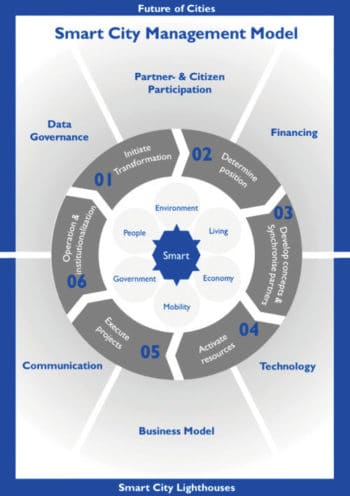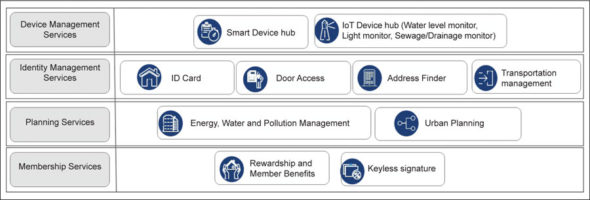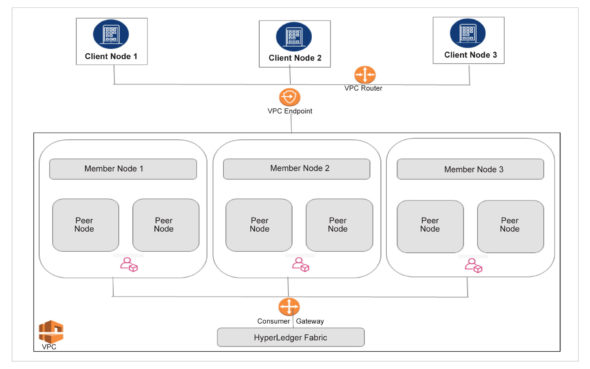As the digital economy grows and matures, the smart cities movement is gaining momentum. For many people this represents the promise of high-tech cities, with autonomous cars on the streets, drones delivering food, and connected devices helping city dwellers to perform a myriad of activities. This article investigates the role blockchain can play in the administration of a smart city.
The 21st century is the century of cities. There is a clear trend of population aggregation in medium-sized and big cities, with urban areas growing all over the world and competing for economic investment, a skilled workforce and cultural prominence. Some cities leading this trend, such as Shanghai, Singapore, Tokyo, London, Dubai or New York, among many others, are already world business and technology hubs, with their world significance (and GDP) sometimes outstripping that of many countries.
However, this increasing importance of cities in the world’s economy does come with a price. Population growth, environmental demands and economic downturns bring many challenges to cities all over the world, and not only to the largest ones.
Gassman, Böhm and Palmié have summarised the most important challenges cities face today: new urbanisation trends that reshape cities and their surroundings, changes in lifestyles and preferences, demographic developments (like the increasing number of elderly people in western countries), overloaded infrastructure, poor air quality, smog, noise, mobility issues, tourism, limited resources and management of the urban commons.
What is a smart city?
The definition of a smart city given above is broad. However, there are a few things that smart cities have in common. The most important one is the digital shadow. It is a prerequisite for any smart city to create a raw input of data about the city, which will come from an interconnected network of sensors, devices, and other digital services and products. Just imagine a city where thousands (or even hundreds of thousands) of sensors record information about air quality, temperature, traffic, energy consumption in buildings, smog, garbage production, or humidity. The data is continuously uploaded to the cloud, creating a digital image of the ‘behaviour’ of the city, available online at every moment. This digital shadow is possible because of the latest achievements in connectivity, especially the Internet of Things — a set of technologies that connects ‘intelligent’ objects through the Internet, adding another layer of data.
The resulting corpus of data becomes the foundation for many other services and products, created by institutions and companies that might build second-layer solutions. For instance, an app could be created that allows citizens to improve their mobility with eco-friendly and connected solutions. Another app could help building owners improve energy efficiency through data and algorithms that control heating and cooling in real-time. A service that connects government officials and citizens, improving their communication by digital means, could be offered by an app too. Other applications might be related to urban farming, tele-health, air quality, data management, or even toilets-as-a-service!
The range of potential solutions that can be built over the digital shadow is vast and is continually growing. These solutions can be broken down into the following six areas:
1. Smart environment – minimising the ecological footprint of a city.
2. Smart living – improving the quality of life in the city.
3. Smart economy – increasing the city’s competitiveness.
4. Smart mobility – creating new and sustainable mobility options in the city.
5. Smart government and governance – promoting the participation of citizens and increasing transparency in the public sector.
6. Smart people – preserving and increasing the human capital of a city, helping people to develop their full potential and fostering their participation in social life.
Smart city management model (SCMM)
The SCMM, shown in Figure 1, addresses the main dimensions of any smart city project:
- The services areas, in the centre of the figure, summarise the kind of initiatives undertaken in a smart city project.
- The transformation cycle process, depicted as a circle in Figure 1, shows the necessary steps needed to succeed when building a smart city programme: initiate transformation, determine location, develop concepts and synchronise partners, activate resources, and realise projects as well as operation and instrumentation.
- The fundamental elements, shown around the perimeter of the figure, are data governance, partner and city participation, financing, technology, business models and communication.

Smart city initiatives and digitisation are making sweeping changes in the lives of citizens. The move is aimed at providing governance like never before. Digitisation and technology solutions have improved the speed of information exchange, enabling better administration. Smart city and digital governance are meant to improve the quality of life and living standards of citizens, and make public utilities seamlessly accessible to them. Here is how this can be done.
1. Improved project management: A smart governance portal allows key decision makers to automate important reporting metrics for tracking projects. These decision makers will have all the critical information needed to take timely action for completing quality projects as per the schedule.
2. Grievance management: Good governance requires handling citizens’ grievances and complaints with urgency. Quite often, administrators lack the necessary data metrics for tracking the execution of these grievances. But with digitisation, citizens can log their complaints through their mobile devices from any location. So, whether it is a water, electricity, transportation or housing problem grievance, all you need to do is log the complaint and track it online. Administrators can also get information about average time to service a citizen fault, best performing departments, departments with maximum pending complaints, etc. This information is necessary for improving the standard of execution as well as citizens’ services.
3. Business platform: Smart governance initiatives can help businesses get all clearances from a single digital window. In addition, the government can create online forums for exchange of information between various businesses, provide a platform that can be used by companies to show their innovative work, etc. This online portal may be used for investor meets, bringing in foreign investments to connect with local businesses. A thriving local business means creation of jobs, increased tax collection and better opportunities for citizens.
4. Tracking the performance of citizens’ services: Automation of key citizen services can help decision makers with key data pointers; e.g., the downtime of a key public utility, the electricity outages, the average time to service a fault, etc, can all be analysed with concrete data. The data for various public utilities can be mapped and tracked with smart automation. The quality of roads, transport facilities, water, electricity and Wi-Fi supply, etc, can be improved with digitisation and smart governance.
5. Tourism: Tourism is one of the top revenue generation sources for governments. Promoting tourism creates opportunities for citizens and local merchants. With smart city initiatives, the government can provide tourist interaction services through a portal. Hotel bookings, site visits and grant of visas can also be facilitated through online travel portals. Tourists can use smart city portals for all their queries, feedback and making online reservations. Tourism not only promotes cultural ties but also helps to improve the economic development and prosperity of a city.
6. Healthcare system: Smart city projects and digitisation are meant to improve the quality of public health utilities. Efficient governance means proactively responding to queries and health problems of citizens, and engaging with them through digital channels. Digital governance and smart city management is aimed at creating a positive impact in the lives of its citizens.
Blockchain in smart city administration
Blockchain technology, contrary to popular perception, is not merely the basis of the cryptocurrency Bitcoin. This system for carrying out verifications and secure transactions on the Internet promises to revolutionise the management of smart cities. With blockchain, different city services can be efficiently coordinated, integrated and controlled with transparency, keeping citizens’ privacy in mind.
The various advantages of using blockchain for governing cities are listed below.
- Increased transparency and connectivity: Cities can interconnect using blockchain vertical services, such as mobility, energy or security, through a single, open, accessible, transversal system that is able to exchange data with their inhabitants in real-time.
- Direct communication: Blockchain makes it possible for government departments and the public to interact digitally, without the need for intermediaries. This would speed up, for example, bureaucratic procedures at registries, town halls, etc.
- Integrity of information: With this technology it is possible to encrypt a file totally or partially in order to share only the part that is of interest, privately, securely and without the risk of it being manipulated by a third party.
- Efficient management: Blockchain allows both public and city officials to know the origin and destination of each resource. In addition, the latter can find out how city services are being used without compromising people’s privacy.
- Enhanced security: Blockchain improves the protection of the personal data collected.
- Saving energy: Smart blockchain based contracts make it easier for solar-powered households to automatically trade surplus electricity with other members of the grid.
Commuting incentives: Government departments can know which citizens use their cars daily, and offer them discounts and advantages to encourage them to take public transport. - Improved waste management: Blockchain can provide the public and waste collection services with real-time information on containers so that they can always know whether these are full or empty.
Better public participation: Blockchain platforms guarantee the security, reliability, transparency and anonymity of public consultations such as elections, surveys, referendums, etc. In addition, blockchain technology can benefit other services such as water resource management, air quality control, or park and garden care.
OrgBook architecture
The blockchain platform, with its decentralised network based architecture, is commonly used in fintech industries like banking, insurance and capital markets for a lot of use cases like know your customer (KYC), credit risk management, and fee calculations or draft approvals, to name a few. For some years now, there are many use cases being experimented in other domains too, like the healthcare industry for distributed patient and doctor database handling using a secured public network, or the retail industry for processing inventories.
The Blockchain LIVE conference of 2019 had some excellent discussions on how to use blockchain to invent options for next generation infrastructure when designing smart cities. One of the key topics for discussion was how blockchain and smart city initiatives marry in terms of solutions and feature provisions. Transparency and security are core fundamentals in smart city planning and infrastructure requirement. There are many use cases in smart city initiatives that can use cloud based blockchain platforms for infrastructure development and management.
In British Columbia, a community effort called the Verifiable Organizations Network (VON) has put together the OrgBook, a searchable public directory of legally registered organisations based on the Hyperledger platform. OrgBook showcases the benefits of an open, unified trusted network of various organisations and associations for the benefit of people and services across a city or province.
The implementation of OrgBook in smart city administration using blockchain based distributed network administration really helps in cutting red tape (reducing paper work and delays in administrative matters), and improves the efficiency of public administration with real-time workflow management like social security verification, and address registration/de-registration, to name a few.
In blockchain based architecture like that of OrgBook, smart city administration is handled efficiently by designing various use cases as decentralised solutions (service fabric implementation). The decentralised database is used to display public data in a verifiable and authentic manner, empowering individuals (smart city members or the government authority) or entities (different role based access in administration services) to manage their identity (without the need of manual verifiable services).
The architecture involves the development of a mobility service called Citizen Wallet App, which has the following features:
- End users and associated family members to identify, store and share DID (decentralised identifiers) based proofs Service for associations and member groups to issue/verify DID based proofs
- Administrative functions like authorisation of certificates, certificate issuance and public notices
- Verification services like authorising identity, providing access rights and approvals
Other solutions in smart city administration
Cloud service providers like AWS and Azure provide blockchain network service components like Hyperledger Fabric using custom cloud service implementation and integration with other cloud service components.

For example, Azure provides cloud service integration for Hyperledger solutions (as shown in Figure 2) using:
- VPC peering for peer node integration
- Interface development using Service Fabric
- Resource group management for handling Hyper Fabric
- Data store for ledger management services
- App services for rule implementation
This architecture can be implemented using AWS based architecture by using VPC peering, peer node services and Fabric components, as shown in Figure 3.

Future implementations in smart city administration using blockchain
Blockchain could be a great ally in the development of smart cities. Indeed, the need for the use of this technology is closely aligned with the needs of smart cities, which are:
- Multiple agents sharing information (society is hyperconnected and will become ever more so; the number of devices per person will also grow).
- Constant updation of data.
- The need to verify that shared data—and updates thereof—are valid.
- Simplification of management, which gets complicated due to the existence of intermediaries.
- Fast-paced, agile connections and participants who interact with one another.
Given this cocktail, the added value of blockchain lies in the possibility of sharing only the information that a participant wishes to know, while keeping everything else encrypted and inaccessible. Cryptography can be used to prevent manipulation, modification of information and privacy violations. It seems logical that the ‘de-intermediated’ agent—the city government—will try to resist the implementation of blockchain. In the world of Blockchain4Cities, however, business models are under no threat. On the contrary, public administrators will have no problem relinquishing their intermediary role so long as all the other roles having to do with control, security, privacy, efficiency, transparency, etc, remain intact.
Cities such as Santiago, Toronto, Tel Aviv, Oslo, Milan, London and Stockholm are already developing blockchain based projects. Dubai has become the world capital of blockchain development by launching the Dubai Blockchain Platform and the Dubai Blockchain Policy.

Handling security and compliance issues in blockchain smart city administration
Smart city administration has many use cases that require an efficient platform like cloud based blockchain architecture to carry out self-healing and auto-scaling services on-the-fly in real-time.
Blockchain based smart city administration uses the advantages of a permissioned ledger based blockchain platform that are listed below.
Shared ledger: This helps to build a multi-transaction system with ‘a single point of failure’.
Consensus: This makes the transaction commit/complete only when all the parties (nodes) agree to network a verified transaction.
Immutability: This enables smart administration activity to be transparent and foolproof from tampering.
Smart contract: This sets a defined, rule based transaction communication using a piece of code so that transactions can be coupled with validation, proof verification and tax calculation.
Provenance: Due to the nature of a distributed blockchain, the entire transaction is copied in all the nodes in the platform, and every node travel for a transaction is captured in the history of the transaction for quickly tracking the stages.
These benefits make blockchain based smart city administrations have agility and flexibility with respect to the architecture. Using digital IDs also makes smart city transactions secure.



















































































